Fix-it-Yourself--Major Appliances: EMERGENCY GUIDE
| HOME | Troubleshooting | DIY Tips |
|
Preventing appliance problems. A faulty appliance usually creates a minor, temporary annoyance—the icemaker won’t make ice, or the clothes washer doesn’t drain. On rare occasions, however, mechanical failure in an appliance, coupled with your home’s electrical, gas or plumbing systems, can cause a real hazard. You can prevent most appliance-related mishaps by exercising the commonsense precautions presented here. The key to appliance safety is proper use and regular maintenance of the machines themselves, and the household utilities that power them. Eager to help you use their products safely, appliance manufacturers provide a Use and Care manual with every new appliance. Several major manufacturers offer toll-free con sumer “hot lines” for answering questions immediately, and they will mail you a Use and Care manual free upon request. Their telephone numbers are available from the 800 operator. The repair of major appliances need not be any more dangerous than their daily use. In fact, proper repairs will prevent hazardous conditions caused by wear and neglect. The list of safety tips at right covers basic guidelines for safe service and use of any appliance; see the sections on individual appliances for more specific advice. Accidents may befall the most careful of households. Fire, the most insidious, can be deprived of its sneak attack by judiciously placed smoke alarms, and a fire extinguisher can snuff the blaze before it gets the upper hand. Learn how to choose and use these safety tools. The Troubleshooting Guide on puts emergency procedures at your fingertips. It lists the quick-action steps to take, and refers you to the procedures for more detailed instructions. Read the emergency instructions thoroughly before you need to use them. And familiarize your self with the Tools and Techniques section, which covers your home’s electrical, gas and plumbing systems. When in doubt about the safety of an appliance or your ability to handle an emergency, don’t hesitate to call for help. Post the telephone numbers for the fire department, gas company and electric company near the telephone. Even in non-emergency situations, they can answer questions concerning the proper use of appliances and household utilities. SAFETY TIPS1. Familiarize yourself with the Use and Care manual for each appliance. It you have misplaced the manual, purchase one from a parts distributor, or call the manufacturer’s toll-free number for a new copy. 2. Before attempting any repair in this guide, read the entire repair procedure. Familiarize yourself with the specific safety information presented for each appliance. 3. Let a heating appliance, such as a dryer or range, cool completely before starting repairs. 4. Before servicing an appliance, unplug the power cord or disconnect power at the service panel. Leave a note on the panel so that no one reconnects the power while you are working. 5. Label your electric service panel with the locations of the appliance circuit breakers or fuses. 6. Light the work area well, and do not reach into any area of the machine you cannot see clearly. 7. Beware of sharp metal edges and pointed screws; pad them with masking tape to avoid cutting yourself. 8. Never bypass or alter any appliance switch or component. Do not remove the ground plug of a 3-prong power cord. 9. Use only replacement parts and wiring of the same specifications as the original part. If in doubt, ask the appliance parts dealer. 10. When reassembling an appliance, take care that all wire connections are secure, and that no wires are pinched between panels or moving parts. 11. Completely reassemble an appliance before reconnecting the power, water or gas supply. 12. If in doubt about the safety of an appliance, call a professional service technician. 13. Label the shutoff valves for gas appliances, as well as the house’s main gas valve. 14. Never light a flame while working on a gas appliance. 15. Know where the water shutoff valves are for the washer, dishwasher and icemaker, as well as the house’s main water shutoff valve. Label them. 16. If hot water is not used for two weeks or more, hydrogen can build up in the hot-water heater and pipes. Before turning on appliances that use water, run all hot water taps in the house for two minutes to clear out the gas. 17. Post emergency, utility company and repair service numbers near the telephone. 18. Install smoke detectors and fire extinguishers in your home. 19. Do not allow children to play on or operate appliances. TROUBLESHOOTING GUIDE
FIRE EMERGENCIES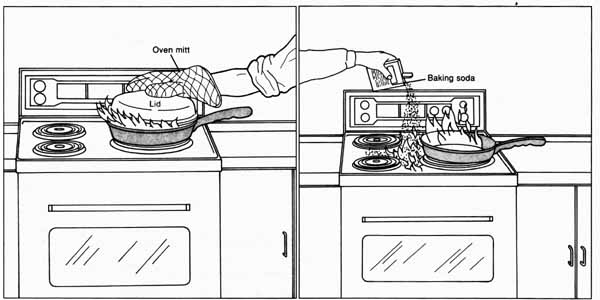
Smothering a cooking fire in a pan. Do not move the pan. Turn off the burner controls and the range hood fan. Protecting your hand with an oven mitt or a pot holder, slide a fitted lid onto the pan, as shown. If no lid is available, use a plate or platter a bit larger than the pan. Do not clap the cover straight down; the rush of air can spread the flames. Let the pan cool before removing the cover. If the fire spreads, apply baking soda (next step). Controlling a cooking fire on the range to not move the pan. Turn off the burner controls and the range hood fan. Pour baking soda liberally over the flames until they are out (above), If baking soda is not available, use salt. Caution: Do not put water, baking powder or flour on a cooking fire; they will spread the flames. Allow the range to cool before removing the pan and cleaning the range to the fire spreads, use a fire extinguisher (next Step). 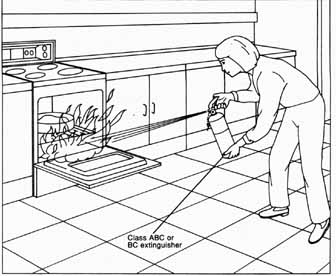
Using a fire extinguisher. To snuff an oven fire, first turn off the oven control and close the door; lack of oxygen should kill the flames. If a range fire—or any appliance fire—spreads, use a fire extinguisher rated ABC or BC. Stand near an exit, 6 to 10 feet from the fire. Pull the lock pin Out of the extinguisher handle and, holding the extinguisher upright, aim the nozzle at the base of the flames. Squeeze the two levers of the handle together, spraying in a quick side-to-side motion. The fire may flare and appear to grow at first before subsiding. If the discharge stream scatters the flames, move back. Keep spraying until the fire is completely extinguished. Watch carefully for “flashback,” or rekindling, and be prepared to spray again. Allow the appliance to cool completely before cleaning it. SAFETY ACCESSORIES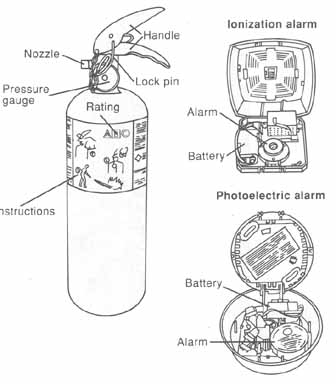
A household fire extinguisher. Best for use in the home is a multipurpose dry-chemical extinguisher rated ABC (left), which is safe and effective against fires in upholstery, kitchens and electrical appliances alike. An extinguisher of convenient size holds a pressurized cargo of 2 1/2 to 7 pounds. Check the pressure gauge monthly; after any discharge or loss of pressure, have the tank recharged professionally or buy a new extinguisher. Mount extinguishers, using the wall bracket provided, near doors to the kitchen, utility room, garage and basement. Ionization alarm: Two kinds of smoke alarms. Ionization alarms (left, top), which sense atomic particles, respond quickly to hot tires with little smoke, but they tend to set off annoying false alarms in the presence of normal cooking fumes. Photoelectric alarms (left, bottom) “see” smoke molecules; they respond best to the smoldering typical of cooking, appliance and upholstery fires. Install at least one smoke alarm in a central hallway on every floor of the house, near the kitchen, bedrooms and head of the stairs, as well as in the garage and basement. Mount a battery-powered smoke alarm on the ceiling. Replace the battery once a year— the detector emits a chirping sound when the battery runs low. ELECTRICAL EMERGENCIES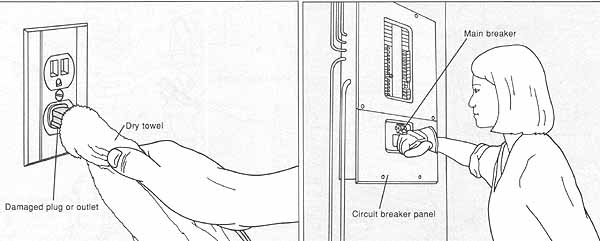
Pulling the power cord. Caution: If you are standing on a wet floor, or the outlet or plug is sparking, burning or melting, do not touch the power cord; instead, disconnect power at the service panel (next step). It the appliance sparks, shocks you, feels abnormally hot or is burning, disconnect the power cord. Protect your hand with a thick dry towel or a heavy work glove. Without touching the machine, grasp the cord several inches from the plug and pull it out (above). Disconnecting power at the service panel. If the floor is wet, or the appliance outlet is burning or sparking, wear heavy, dry gloves and put one hand behind your back. Flip off the breaker, or unscrew the fuse, that controls the appliance’s circuit. (A dryer or range may have two breakers or fuses.) If you are unsure of the circuit, shut off the main power breaker. Use the back of your hand (above); any shock will jerk your hand away from the panel. To disconnect a main fuse block, insert a dry wooden stick behind the handle and pull it out. GAS EMERGENCIES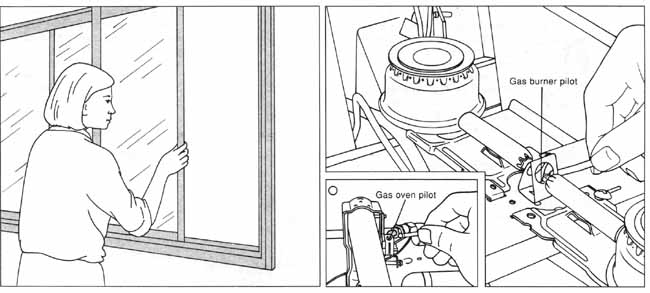
1. Ventilating a gas-filled room. First open all windows and doors in the room (above). Caution: Extinguish all flames, except for pilot lights. Do not use electrical switches or out lets—a spark could ignite the gas. Turn off controls to all gas appliances in the room. When the gas has dissipated, relight any pilots that are out (step 2). If the gas does not dissipate, leave the house and call the gas company. 2. Relighting a pilot. Check all the pilots in every gas appliance in the house to find the pilots that are out. (If you don’t know where the pilots are, consult the appliance’s Use and Care manual or the access instructions in this guide.) Wait a minute for gas in the appliance to dissipate, then light the pilot with a match as shown for a gas range (above) or oven (inset). If the pilot does not light or stay lit, clean or adjust it () and try again. If you smell gas with all pilots lit, or in an appliance with electronic ignition, turn off the gas supply (step 3). 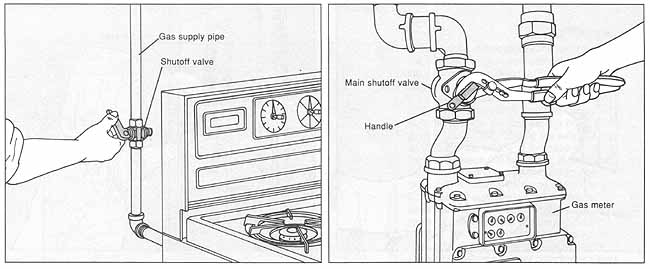
3. Turning off the gas supply. If the appliance has a valve on its gas supply pipe, turn the handle perpendicular to the pipe to shut off the gas (above, left). If the gas in the room does not dissipate, leave the house and call the gas company. The gas supply to the whole house may be turned off at the meter; using a wrench, turn the main valve so that its handle is perpendicular to the pipe (above, right). Leave the house and call the gas company. WATER EMERGENCIES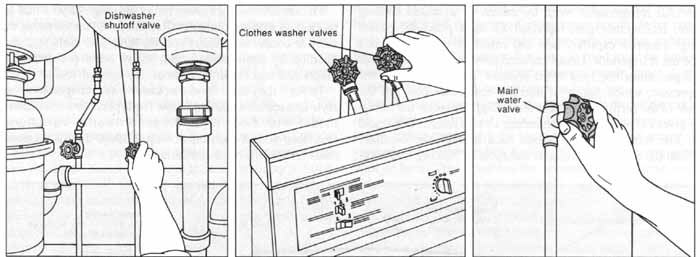
1. Turning off the water supply. Caution: If an electrical appliance is submerged, do not enter the room; disconnect power at the service panel. If an appliance is leaking or overflowing, unplug the power cord (), then turn off the water at the valve to the appliance. For a dishwasher, the valve is usually under the sink (above, left). Clothes washer valves are on the wall behind the machine (above, center) or at the utility sink faucet; shut off both the hot and cold water supply. If the valve is leaking, or there is no valve, turn oft the house water sup ply at the main valve (above, right), located near the water meter or where the main water supply pipe enters the house. 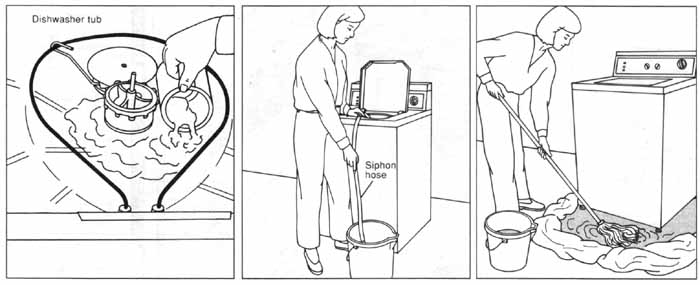
2. Emptying an appliance of water. If a clothes washer stops working in the wash or rinse cycle, try setting it on the spin cycle to drain the water. To empty an overflowing dishwasher, turn off the water valve under the sink (step 1) and turn on the dishwasher. If a water-filled appliance does not work at all, unplug it and let the water cool. Bail Out the water (above, left), or use a hose to siphon it out into a bucket on the floor (above, right). To start the water flow, suck on the end of the hose; the flow will continue as long as the end of the hose is lower than the level of the water. 3. Damming a leak. Disconnect power to the appliance without step ping in the water. To keep water on the floor from spreading, surround it with a dam of washable, rolled- up rugs or towels. Clean up water within the dammed area with a mop or heavy cotton towels, not paper towels. Prev: Intro/Contents Next: REFRIGERATORS (part 1) Home top of page |